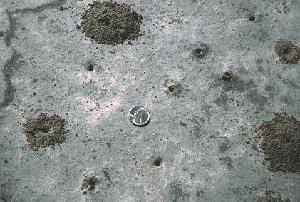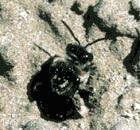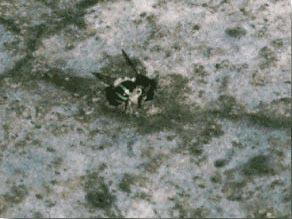Alkali Bee Gallery
Alkali Bee Publications
The alkali bee (Nomia melanderi) is a solitary ground nesting bee native to western North America. As its name suggests, it can be found nesting in alkali soil. It prefers to nest in bare soil that remains moist but not wet, and dry on top. This occurs naturally in areas where a layer of hard pan exists in alkali soils. The alkali salts seal the top of the soil, holding in the moisture.
The bee is slightly smaller than the honey bee with yellow or green iridescent bands on the abdomen. The females carry pollen on the hind legs and dig holes in the soil where they make their nests. Most nest cells are between 4 and 8 inches below the surface. The pollen is molded with nectar into a ball. The female then lays an egg on the ball. The egg hatches and the larva feeds on the pollen and nectar ball until it reaches the mature larval stage. It overwinters in this stage and then pupates and emerges as an adult in the spring after a sufficient number of heat units have accumulated. There is usually a single generation each year. In California there are two generations.
 An artificial nesting bed can be constructed where bees are desired. An area of silt loam soil is ideal, but the bees will nest in other soils. Next the area should be excavated 1 to 3 feet deep. The site should then be lined with an 8 mil plastic tarp. A layer of straw is added to protect the tarp. Then a layer of 1 inch gravel 8 to 10 inches deep is placed over the straw. The gravel helps to spread the water evenly throughout the bed. Straw or burlap is then added over the gravel to keep soil from plugging it up. Concrete stand pipes are then placed at regular intervals throughout the bed. These are used to irrigate the bed from the bottom. Next the soil is added back to the site and packed down. It is important to make the bed convex or mounded so that rain water can not form puddles on the bed.
An artificial nesting bed can be constructed where bees are desired. An area of silt loam soil is ideal, but the bees will nest in other soils. Next the area should be excavated 1 to 3 feet deep. The site should then be lined with an 8 mil plastic tarp. A layer of straw is added to protect the tarp. Then a layer of 1 inch gravel 8 to 10 inches deep is placed over the straw. The gravel helps to spread the water evenly throughout the bed. Straw or burlap is then added over the gravel to keep soil from plugging it up. Concrete stand pipes are then placed at regular intervals throughout the bed. These are used to irrigate the bed from the bottom. Next the soil is added back to the site and packed down. It is important to make the bed convex or mounded so that rain water can not form puddles on the bed.
 Lastly, salt is added to the top at the rate of 1 to 2 pounds per square foot to seal in the moisture. Water is added through the stand pipes to maintain the moisture between 8 and 32%. Alkali bees can be obtained in cubes of soil which are then placed in the new artificial bed. Adults can also be transferred to new beds. Small holes are punched into the bed with a pitchfork, then adults collected from another site are released at the new site at night. It is possible to have populations of up to 125 nests per square foot in artificial beds.
Lastly, salt is added to the top at the rate of 1 to 2 pounds per square foot to seal in the moisture. Water is added through the stand pipes to maintain the moisture between 8 and 32%. Alkali bees can be obtained in cubes of soil which are then placed in the new artificial bed. Adults can also be transferred to new beds. Small holes are punched into the bed with a pitchfork, then adults collected from another site are released at the new site at night. It is possible to have populations of up to 125 nests per square foot in artificial beds.
The female alkali bee has a stinger but rarely uses it. No protective clothing is needed when working near these bees. The alkali bee is an excellent pollinator of alfalfa and onion seed.
References
Baird, C.R., D.F. Mayer, and R.M. Bitner. 1991. Pollinators. In Alfalfa Seed Production and Pest Management. Western Regional Extension Publication 12.

